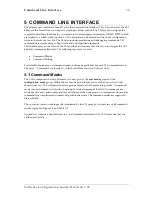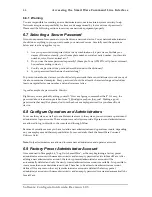
30
Configuration Concepts
The chapter sections that follow refer to Figure 4-1 and describe the concepts and elements in more
detail.
4.2 Contexts and Gateways
4.2.1 Context
A SmartWare
context
represents one specific networking technology or protocol, namely IP (Internet
Protocol) or CS (circuit-switching). A context can be seen as ”virtual dedicated equipment” within
the SmartNode. For example:
•
A CS context contains the circuit-switching functions of the SmartNode. It can be seen as an
embedded multiplexer or cross-connect within the SmartNode
•
An IP context contains the routing functions of the SmartNode. It can be seen as a embedded
router within the SmartNode
The contexts are identified by a name, and contain the configuration commands that are related to
the technology that they represent. By means of the context concept a separate configuration can be
built for newly supported network layer technologies without complicating the configuration
methods of existing features. For example, as bridging, ATM or FR switching become available so
can a bridging, ATM; or FR context be introduced.
Each context contains a number of
interfaces
, which build the connections to other SmartWare
elements and the outside world. Figure 4-1 shows two contexts: one of type IP named “router”, and
one of type CS named “switch”. This corresponds to the default configuration of all SmartNodes.
Note
SmartWare currently supports only one instance of the CS and IP context types.
Examples
The IP context named “router” can contain static routes, RIP and NAT configuration parameters. The
circuit-switching context named “switch” can contain number translations, local breakout conditions
and least-cost routing parameters.
4.2.2 Gateway
For the communication between contexts of different types the concept of a
gateway
is introduced. A
gateway handles connections between different technologies or protocols. For example: an H.323-
Gateway can connect an IP context to a circuit-switching context.
The gateways are each of a specific type and are identified by a name. Each named gateway contains
its configuration parameters. With this concept, a separate gateway can be built for newly-supported
technology such as MGCP or SIP without complicating the configuration methods of existing
software parts. Figure 4-1 shows two gateways, one of type h323 named “h323gw” and one of type
ISoIP named “isoipgw”.
Example
An H.323 gateway named “h323-gw” has an H.323 gateway ID and an associated gatekeeper
configuration. It is connected to the interface “ip-trunk” on the circuit-switch context “switch” and
the interface “global-wan” on the IP context “router”.
4.3 Interfaces, Ports and Bindings
4.3.1 Interfaces
The concept of an interface in SmartWare differs from that in traditional networking devices. The
traditional use of the term interface
is often synonymous with port or circuit, which are physical
Software Configuration Guide, Revision 1.03
Summary of Contents for SmartWare R2.00
Page 2: ......
















































